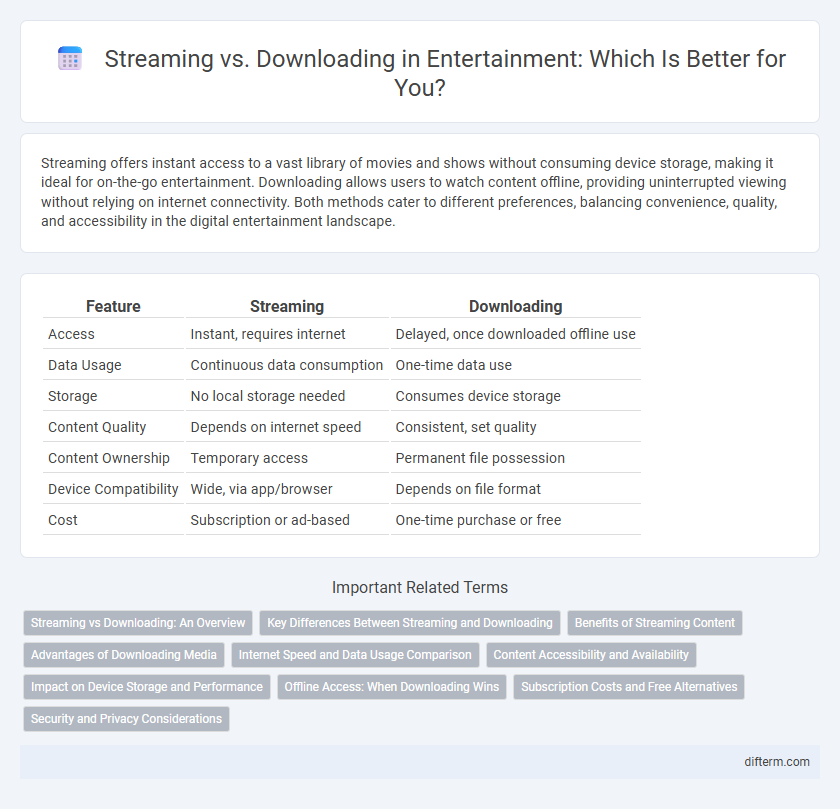Streaming offers instant access to a vast library of movies and shows without consuming device storage, making it ideal for on-the-go entertainment. Downloading allows users to watch content offline, providing uninterrupted viewing without relying on internet connectivity. Both methods cater to different preferences, balancing convenience, quality, and accessibility in the digital entertainment landscape.
Table of Comparison
| Feature | Streaming | Downloading |
|---|---|---|
| Access | Instant, requires internet | Delayed, once downloaded offline use |
| Data Usage | Continuous data consumption | One-time data use |
| Storage | No local storage needed | Consumes device storage |
| Content Quality | Depends on internet speed | Consistent, set quality |
| Content Ownership | Temporary access | Permanent file possession |
| Device Compatibility | Wide, via app/browser | Depends on file format |
| Cost | Subscription or ad-based | One-time purchase or free |
Streaming vs Downloading: An Overview
Streaming delivers instant access to content by transmitting data continuously over the internet without requiring permanent storage, making it ideal for real-time viewing and saving device space. Downloading involves saving a complete file to a device, allowing offline access and higher-quality playback without buffering or dependence on internet speed. Understanding these differences helps users choose between convenience and control based on their entertainment needs and connectivity.
Key Differences Between Streaming and Downloading
Streaming allows immediate access to audio and video content via an internet connection without storing files locally, enabling real-time consumption but requiring continuous bandwidth. Downloading saves the entire media file to a device, permitting offline access and no dependence on internet speed after the download completes. Key differences include data usage patterns, storage requirements, and user experience, with streaming favoring instant access and downloading prioritizing persistent availability.
Benefits of Streaming Content
Streaming content offers instant access to a vast library of movies, TV shows, and music without the need for large storage space on devices. It enables real-time updates and recommendations based on user preferences, enhancing personalized entertainment experiences. Seamless multi-device compatibility ensures users can enjoy content anywhere with an internet connection, eliminating the wait time associated with downloads.
Advantages of Downloading Media
Downloading media offers uninterrupted access to entertainment content, allowing users to enjoy movies, music, and shows offline without buffering issues. Files are stored locally on devices, ensuring consistent playback quality regardless of internet speed or connectivity interruptions. This method also provides convenience for travel and remote areas where streaming services may be unreliable or unavailable.
Internet Speed and Data Usage Comparison
Streaming requires a consistent high-speed internet connection to deliver uninterrupted content, typically consuming data at rates between 3 to 7 GB per hour for HD quality. Downloading allows users to save content locally, using bandwidth only once, which can be beneficial for limited or slow internet connections. Compared to streaming, downloading often results in more efficient data usage since repeated playback does not consume additional bandwidth.
Content Accessibility and Availability
Streaming offers instant access to a vast library of content across multiple devices without storage limitations, enhancing convenience and variety for users. Downloading provides offline availability, ensuring uninterrupted viewing without reliance on internet connectivity, which is essential in low-bandwidth areas. Both methods impact content accessibility and availability differently, shaping user experience based on preferences and network conditions.
Impact on Device Storage and Performance
Streaming entertainment content minimizes the impact on device storage by allowing users to access media without storing large files locally, preserving valuable storage space. Downloading, however, consumes significant device storage and may slow performance due to increased read/write operations, especially on devices with limited memory capacity. Devices with high storage and processing power handle downloads more efficiently, but streaming remains the preferred option for maintaining optimal device performance and avoiding storage constraints.
Offline Access: When Downloading Wins
Downloading offers a significant advantage in offline access by allowing users to save entertainment content directly on their devices, eliminating the need for a constant internet connection. Streaming depends heavily on stable, high-speed internet, which can be unreliable in remote or low-signal areas, leading to interruptions or degraded quality. Downloaded content ensures uninterrupted viewing or listening anywhere, making it the preferred choice for offline entertainment in locations without internet access.
Subscription Costs and Free Alternatives
Streaming services often require monthly subscription fees ranging from $5 to $20, offering access to extensive libraries and exclusive content. Downloading content may involve one-time purchases or rentals, sometimes costing less but lacking the breadth of continuously updated offerings. Free alternatives like ad-supported platforms provide no-cost access with limitations in quality and content availability, appealing to budget-conscious viewers.
Security and Privacy Considerations
Streaming minimizes the risk of malware infections compared to downloading, as content is not permanently stored on devices, reducing exposure to potentially harmful files. Privacy concerns intensify with downloading, where locally stored media may be accessed by unauthorized applications or compromised through data breaches. Streaming platforms often use encrypted connections (HTTPS) to safeguard user data, enhancing overall security during content consumption.
streaming vs downloading Infographic

 difterm.com
difterm.com